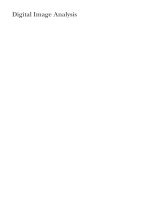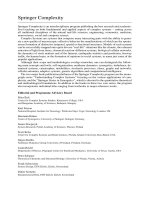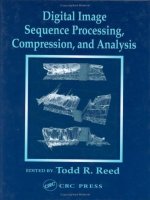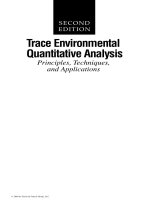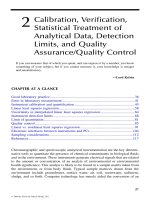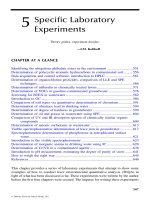kropatsch, bischof - digital image analysis selected techniques and applications
Bạn đang xem bản rút gọn của tài liệu. Xem và tải ngay bản đầy đủ của tài liệu tại đây (11.7 MB, 512 trang )
Digital Image Analysis
Springer
New York
Berlin
Heidelberg
Barcelona
Hong Kong
London
Milan
Paris
Singapore
Tokyo
Walter G. KropatschMMHorst Bischof
Editors
123
Digital Image Analysis
With 150 Illustrations
Selected Techniques
and Applications
Walter G. Kropatsch
Pattern Recognition and
Image Processing Group
Institute of Computer Aided
Automation
Vienna University of Technology
Favoritenstrasse 9/183/2
Vienna A-1040
Austria
Horst Bischof
Pattern Recognition and
Image Processing Group
Institute of Computer Aided
Automation
Vienna University of Technology
Favoritenstrasse 9/183/2
Vienna A-1040
Austria
Library of Congress Cataloging-in-Publication Data
Digital image analysis: selected techniques and applications/editors, Walter G.
Kropatsch, Horst Bischof.
p.Mcm.
Includes bibliographical references and index.
ISBN 0-387-95066-4
1. Image processing—Digital techniques.M2. Image analysis.MI. Kropatsch, W. (Walter).
II. Bischof, Horst.
TA1637.D517M2001
621.36’7—dc21 00-052278
Printed on acid-free paper.
© 2001 Springer-Verlag New York, Inc.
All rights reserved. This work may not be translated or copied in whole or in part without the written
permission of the publisher (Springer-Verlag New York, Inc., 175 Fifth Avenue, New York, NY 10010,
USA), except for brief excerpts in connection with reviews or scholarly analysis. Use in connection
with any form of information storage and retrieval, electronic adaptation, computer software, or by
similar or dissimilar methodology now known or hereafter developed is forbidden.
The use of general descriptive names, trade names, trademarks, etc., in this publication, even if the
former are not especially identified, is not to be taken as a sign that such names, as understood by the
Trade Marks and Merchandise Marks Act, may accordingly be used freely by anyone.
Production managed by Frank M
c
Guckin; manufacturing supervised by Jeffrey Taub.
Camera-ready copy prepared from the authors’ LaTeX2e files using Springer’s svsing2e.sty macro.
Printed and bound by Maple-Vail Book Manufacturing Group, York, PA.
Printed in the United States of America.
9n8n7n6n5n4n3n2n1
ISBN 0-387-95066-4 SPIN 10770712
Springer-VerlagNNew YorknBerlinnHeidelberg
A member of BertelsmannSpringer Science+Business Media GmbH
Disclaimer:
This eBook does not include the ancillary media that was
packaged with the original printed version of the book.
CD-ROM available only in print version.
Preface
The human visual system as a functional unit including the eyes, the nervous system,
and the corresponding parts of the brain certainly ranks among the most important
means of human information processing. The efficiency of the biological systems is
beyond the capabilities of today’s technical systems, even with the fastest available
computer systems.
However, there are areas of application where digital image analysis systems produce
acceptable results. Systems in these areas solve very specialized tasks, they operate in
a limited environment, and high speed is often not necessary. Several factors determine
the economical application of technical vision systems: cost, speed, flexibility, robust-
ness, functionality, and integration with other system components. Many of the recent
developments in digital image processing and pattern recognition show some of the
required achievements. Computer vision enhances the capabilities of computer systems
• in autonomously collecting large amounts of data,
• in extracting relevant information,
• in perceiving its environment, and
• in automatic or semiautomatic operation in this environment.
The development of computer systems in general shows a steadily increasing need in
computational power, which comes with decreasing hardware costs.
About This Book
This book is the result of the Austrian Joint Research Program (JRP) 1994–1999 on
“Theory and Applications of Digital Image Processing and Pattern Recognition”. This
program was initiated by the Austrian Science Foundation (FWF) and funded research
in 11 labs all over Austria for more than 5 years. Because the program has produced
many scientific results in many different areas and communities, we collected the most
important results in one volume. The development of practical solutions involving digi-
tal images requires the cooperation of specialists from many different scientific fields.
The wide range of fields covered by the participating institutions fulfills this impor-
tant requirement. Furthermore, the often very specialized vocabulary in the different
disciplines makes it necessary to have experts in the different areas, which are in close
contact and often exchange ideas. For this reason, active cooperation among the dif-
ferent groups has been declared an important goal of the research program. It has
stimulated the research activities for each of the participating groups (and beyond) in
vi Preface
a way that has a positive long-term effect for activities in this field in Austria. More
details about the joint research program and the participating labs can be found on the
CD included in this book.
This book is not a collection of research papers; it brings together the research results
of the joint research program in a uniform manner, thereby making the contents of the
more than 300 scientific papers accessible to the nonspecialist. The main motivation
for writing this book was to bridge the gap between the basic knowledge available in
standard textbooks and the newest research results published in scientific papers.
In particular the book was written with the following goals in mind:
• presentation of the research results of the joint research program in a unified
manner;
• together with the accompanying CD, the book provides a quick overview of the
research in digital image processing and pattern recognition in Austria from 1994–
1999;
• parts of this book can serve as advanced courses in selected chapters in pattern
recognition and image processing.
The book is organized in five parts, each dealing with a special topic. The parts are
written in an independent manner and can be read in any order. Each part consists of
several chapters and has its own bibliography. Each part focuses on a specific topic in
image processing and describes new methods developed within the research program,
but it also demonstrates selected applications showing the benefits of the methods.
Parts I, III, and IV are more focused on methodological developments, and Parts II
and V are more application oriented. New mathematical methods centered around the
topic of image transformations is the main subject of Part I. Part II is mainly devoted
to the computer science aspect of image processing, in particular how to handle this
huge amount of information in a reasonable time. Parts III and IV are centered around
algorithmic issues in image processing. Part III deals with graph-based and robust
methods, whereas Part IV is focused on information fusion. 3D information is the main
topic of Part V. Table 1 gives a concise overview of the parts and presents the main
methods and selected applications for each part.
The Compact Disc
The CD included with this book presents the research program from a multimedia
perspective. The CD contains a collection of html-files, which can be viewed by common
Web-browsers. The CD has following features:
• the structure of the research program;
• the main topics of research;
• a collection of scientific papers produced during the research program;
Preface vii
• WWW-links to demo pages, which are maintained by the different labs;
• information about the participating labs; and
• the people working on the various projects.
The WWW-links to the demos on the CD should add to the “static” content of the
book access to the latest developments of active research done in the labs. Although
we are aware of the difficulties of maintaining Internet links over long periods, we have
decided for this dynamic solution in order to communicate up-to-date results in such
rapidly evolving technology as digital image processing.
Acknowledgments
This work was supported by the Austrian Science Foundation under grant S-70 and the
Austrian national bank. We are indebted to Dr. Niel from FWF for continuing support.
We would like to thank all our colleagues who have worked under the Joint Research
Program S-70 for more than 5 years and who have produced the results in this book and
on the CD. Special thanks go to Karin Hraby at the Pattern Recognition and Image
Processing Lab who has supported the research program from the administrative side;
without her invaluable help we would have spent much more time on administration
than on research. For the production of the CD we would like to thank the Hagen-
berg team at the Fachhochschule Multimedia Design, especially Wilhelm Burger for
producing the CD with his students. Special thanks to Tatjana Elssenwenger, Daniela
Kreiss, and Manuela Mittermayr for their excellent work in preparing the CD and for
their patience for working with us. Finally we would like to express our sincere thanks
to all contributors to this book for their professional work and timely delivery of the
chapters.
Vienna, Austria Walter G. Kropatsch
January 2001 Horst Bischof
viii Preface
TABLE 1. Overview of the Book Parts
Methods Selected Applications
I Mathematical Methods for Image Analysis
Time-frequency methods Echocardiography
Signal approximation Geophysics
Gabor analysis Image reconstruction
Wavelet analysis Shape classification
Stochastic shape theory Image compression
Non-linear optimizations Image encryption
Multilevel interpolation Watermarking
Chaotic Kolmogorov flows
II Data Handling
Parallelization Remote sensing
Distributed processing Radar data
Data management Art history
Image databases
III Robust and Adaptive Image Understanding
Graphs Technical drawings
Image pyramids Line images
Irregular pyramids Range images
Robust methods
Minimum Description Length
Object recognition
Structural features
Grouping and Indexing
Machine learning
IV Information Fusion and Radiometric Models for
Image Understanding
Active fusion Remote sensing
Active recognition Car recognition
Reinforcement learning View planning
Generic object recognition Land cover classification
Radiometric models
Sub-pixel analysis
V 3D Reconstruction
Image matching Remote sensing
Object reconstruction Target localization
Topographic mapping Building extraction
Vision-based navigation Space exploration
Rotating CCD cameras Digital elevation models
Surveying
Contributors
Andreu, Jean-Philippe
Joanneum Research
The Institute of Digital Image Processing (DIB)
Wastiangasse 6
A-8010 Graz, Austria
Bachmann, Dieter
Graz University of Technology
Computer Graphics and Vision
Inffeldgasse 16
A-8010 Graz, Austria
Bartl, Renate
University of Agricultural Sciences
Institute of Surveying, Remote Sensing and Land Information
Peter-Jordan-Str. 82
A-1190 Vienna, Austria
Bischof, Horst
Vienna University of Technology
Institute of Computer Aided Automation
Favoritenstr. 9/1832
A-1040 Vienna, Austria
Blurock, Edward
Johannes Kepler University
Research Institute for Symbolic Computation
Altenbergerstrasse 69
A-4040 Linz, Austria
x Contributors
Borotschnig, Hermann
European Patent Office
D-80298 Munich, Germany
Burge, Mark
Armstrong Atlantic University
Department of Computer Science
11935 Abercorn Street
Savannah, Georgia 31419-1997, USA
Burger, Wilhelm
FH-Studiengang Medientechnik und -design
Hauptstrasse 117
A-4232 Hagenberg, Austria
Cenker, Christian
University of Vienna
Department of Statistics and Decision Support Systems
Universit¨atsstr. 5
A-1010 Vienna, Austria
Englert, Roman
DeTeMobil–Deutsche Telekom MobilNet GmbH
Landgrabenweg 151
D-53227 Bonn, Germany
Feichtinger, Hans G.
University of Vienna
Department of Mathematics
Strudlhofg. 4
A-1090 Vienna, Austria
Ganster, Harald
Graz University of Technology
Electrical Measurement and Measurement Signal Processing
Schiesstattg. 14b
A-8010 Graz, Austria
Contributors xi
Glantz, Roland
Vienna University of Technology
Institute of Computer Aided Automation
Favoritenstr. 9/1832
A-1040 Vienna, Austria
Glendinning, Ian
European Centre for Parallel Computing at Vienna (VCPC)
Liechtensteinstr. 22
A-1090 Vienna, Austria
Goller, Alois
Department of Electrical and Computer Engineering
Chalmers Lindholmen University College
P.O. Box 8873
SE-402 72 Goeteborg, Sweden
Kahmen, Heribert
Vienna University of Technology
Department of Applied and Engineering Geodesy
Gusshausstr. 27-29/128/3
A-1040 Vienna, Austria
Kalliany, Rainer
Graz University of Technology
Computer Graphics and Vision
Inffeldgasse 16
A-8010 Graz, Austria
Kropatsch, Walter G.
Vienna University of Technology
Institute of Computer Aided Automation
Favoritenstr. 9/1832
A-1040 Vienna, Austria
xii Contributors
Leonardis, Aleˇs
University of Ljubljana
Faculty of CIS
Trzaska 25
SI-1001 Ljubljana, Slovenia
Mayer Manfred
University of Vienna
Department of Statistics and Decision Support Systems
Universit¨atsstr. 5
A-1010 Vienna, Austria
Niederl Franz
akaryon Niederl & Bußwald OEG
Grazer Straße 77
A-8665 Langenwang, Austria
Niessner, Anton
Vienna University of Technology
Department of Applied and Engineering Geodesy
Gusshausstr. 27-29/128/3
A-1040 Vienna, Austria
Paar, Gerhard
Joanneum Research
The Institute of Digital Image Processing (DIB)
Wastiangasse 6
A-8010 Graz, Austria
Paletta, Lucas
Joanneum Research
The Institute of Digital Image Processing (DIB)
Wastiangasse 6
A-8010 Graz, Austria
Contributors xiii
Pflug, Georg
University of Vienna
Department of Statistics and Decision Support Systems
Universit¨atsstr. 5
A-1010 Vienna, Austria
Pinz, Axel
Graz University of Technology
Electrical Measurement and Measurement Signal Processing
Schiesstattg. 14b
A-8010 Graz, Austria
P¨olzleitner, Wolfgang
Sensotech Forschungs- und Entwicklungs GesmbH
Scheigergasse 74
A-8010 Graz, Austria
Prantl, Manfred
Alicona GdbR
Koch-Sternfeldstr. 5
D-83471 Berchtesgaden, Germany
Rottensteiner, Franz
Vienna University of Technology
Institute of Photogrammetry and Remote Sensing
Gusshausstr. 27-29
A-1040 Vienna, Austria
Saraceno, Caterina
Starlab NV
Boulevard St Michel 47
B-1040 Brussels, Belgium
Scharinger, Josef
Johannes Kepler University
Institute of Systems Science, Systems Theory and Information Technology
Altenbergerstrasse 69
A-4040 Linz, Austria
xiv Contributors
Schneider, Werner
University of Agricultural Sciences
Institute of Surveying, Remote Sensing and Land Information
Peter-Jordan-Str. 82
A-1190 Vienna, Austria
Steinwendner, Joachim
University of Agricultural Sciences
Institute of Surveying, Remote Sensing and Land Information
Peter-Jordan-Str. 82
A-1190 Vienna, Austria
Seixas, Andrea de
Vienna University of Technology
Department of Applied and Engineering Geodesy
Gusshausstr. 27-29/128/3
A-1040 Vienna, Austria
Strohmer, Thomas
University of California, Davis
Department of Mathematics
1 Shield Avenue
Davis California 95616-8633, USA
Contents
Preface v
Contributors ix
List of Figures xxiii
List of Tables xxxi
I Mathematical Methods for Image Analysis 1
Introduction to Part I 3
1 Numerical Harmonic Analysis and Image Processing 7
H.G. Feichtinger and T. Strohmer
1.1 Gabor Analysis and Digital Signal Processing 7
1.1.1 From Fourier to Gabor Expansions 8
1.1.2 Local Time-Frequency Analysis and STFT 15
1.1.3 Fundamental Properties of Gabor Frames 17
1.1.4 Commutation Relations of the Gabor Frame Operator 18
1.1.5 Critical Sampling, Oversampling, and the Balian-Low Theorem . 18
1.1.6 Wexler-Raz Duality Condition 23
1.1.7 Gabor Analysis on LCA Groups 24
1.1.8 Numerical Gabor Analysis 30
1.1.9 Image Representation and Gabor Analysis 34
1.2 Signal and Image Reconstruction 34
1.2.1 Notation 35
1.2.2 Signal Reconstruction and Frames 36
1.2.3 Numerical Methods for Signal Reconstruction 37
1.3 Examples and Applications 40
1.3.1 Object Boundary Recovery in Echocardiography 43
1.3.2 Image Reconstruction in Exploration Geophysics 44
1.3.3 Reconstruction of Missing Pixels in Images 46
2 Stochastic Shape Theory 49
Ch. Cenker, G. Pflug, and M. Mayer
2.1 Shape Analysis 49
2.2 Contour Line Parameterization 51
2.3 Deformable Templates 52
2.3.1 Stochastic Planar Deformation Processes 53
2.3.2 Gaussian Isotropic Random Planar Deformations 54
2.3.3 The Deformable Templates Model 55
xvi Contents
2.3.4 Maximum Likelihood Classification 56
2.4 The Wavelet Transform 58
2.4.1 Atomic Decompositions and Group Theory 59
2.4.2 Discrete Wavelets and Multiscale Analysis 62
2.4.3 Wavelet Packets 67
2.5 Wavelet Packet Descriptors 72
2.6 Global Nonlinear Optimization 74
2.6.1 Multilevel Single-Linkage Global Optimization 75
2.6.2 Implementation 77
3 Image Compression and Coding 81
J. Scharinger
3.1 Image Compression 81
3.1.1 Lossy Compression and Machine Vision 82
3.1.2 Multilevel Polynomial Interpolation 90
3.1.3 Enhancing the FBI Fingerprint Compression Standard 95
3.2 Multimedia Data Encryption 102
3.2.1 Symmetric Product Ciphers 102
3.2.2 Permutation by Chaotic Kolmogorov Flows 103
3.2.3 Substitution by AWC or SWB Generators 108
3.2.4 Security Considerations 111
3.2.5 Encryption Experiments 111
3.2.6 Encryption Summary 114
References 115
II Data Handling 131
Introduction to Part II 133
4 Parallel and Distributed Processing 135
A. Goller, I. Glendinning, D. Bachmann, and R. Kalliany
4.1 Dealing with Large Remote Sensing Image Data Sets 135
4.1.1 Demands of Earth Observation 135
4.1.2 Processing Radar-Data of the Magellan Venus Probe 137
4.2 Parallel Radar Signal Processing 138
4.2.1 Parallelization Strategy 138
4.2.2 Evaluation of Parallelization Tools 139
4.2.3 Program Analysis and Parallelization 141
4.3 Parallel Radar Image Processing 143
4.3.1 Data Decomposition and Halo Handling 144
4.3.2 Dynamic Load Balancing and Communication Overloading . . . 145
4.3.3 Performance Assessment 146
4.4 Distributed Processing 149
4.4.1 Front End 150
4.4.2 Back End 150
Contents xvii
4.4.3 Broker 151
4.4.4 Experiences 153
5 Image Data Catalogs 155
F. Niederl, R. Kalliany, C. Saraceno, and W. G. Kropatsch
5.1 Online Access to Remote Sensing Imagery 156
5.1.1 Remote Sensing Data Management 156
5.1.2 Image Data Information and Request System 158
5.1.3 Online Product Generation and Delivery 159
5.2 Content-Based Image Database Indexing and Retrieval 161
5.2.1 The Miniature Portrait Database 163
5.2.2 The Eigen Approach 166
5.2.3 Experiments 168
References 171
III Robust and Adaptive Image Understanding 175
Introduction to Part III 177
6 Graphs in Image Analysis 179
W.G. Kropatsch, M. Burge, and R. Glantz
6.1 From Pixels to Graphs 179
6.1.1 Graphs in the Square Grid 180
6.1.2 Run Graphs 180
6.1.3 Area Voronoi Diagram 184
6.2 Graph Transformations in Image Analysis 191
6.2.1 Arrangements of Image Elements 191
6.2.2 Dual Graph Contraction 193
7 Hierarchies 199
W.G. Kropatsch, H. Bischof, and R. Englert
7.1 Regular Image Pyramids 199
7.1.1 Structure 201
7.1.2 Contents 203
7.1.3 Processing 203
7.1.4 Fuzzy Curve Pyramid 205
7.2 Irregular Graph Pyramids 208
7.2.1 Computational Complexity 209
7.2.2 Irregular Pyramids by Hopfield Networks 210
7.2.3 Equivalent Contraction Kernels 213
7.2.4 Extensions to 3D 216
8 Robust Methods 219
A. Leonardis and H. Bischof
8.1 The Role of Robustness in Computer Vision 219
xviii Contents
8.2 Parametric Models 220
8.2.1 Robust Estimation Methods 220
8.3 Robust Methods in Vision 221
8.3.1 Recover-and-Select Paradigm 221
8.3.2 Recover-and-Select applied to 227
9 Structural Object Recognition 237
M. Burge and W. Burger
9.1 2-D and 3-D Structural Features 237
9.2 Feature Selection 238
9.3 Matching Structural Descriptions 238
9.4 Reducing Search Complexity 239
9.5 Grouping and Indexing 239
9.5.1 Early Search Termination 240
9.6 Detection of Polymorphic Features 241
9.7 Polymorphic Grouping 241
9.8 Indexing and Matching 242
9.9 Polymorphic Features 242
9.10 3-D Object Recognition Example 243
9.10.1 The IDEAL System 243
9.10.2 Initial Structural Part Decomposition 244
9.10.3 Part Adjacency and Compatibility Graphs 245
9.10.4 Automatic Model Acquisition 247
9.10.5 Object Recognition from Appearances 248
9.10.6 Experiments 249
10 Machine Learning 251
E. Blurock
10.1 What Is Machine Learning? 251
10.1.1 What Do Machine Learning Algorithms Need? 252
10.1.2 One Method Solves All? Use of Multistrategy 252
10.2 Methods 253
10.3 Operational 254
10.3.1 Discrimination and Classification 256
10.3.2 Optimization and Search 256
10.3.3 Functional Relationship 257
10.3.4 Logical Operations 257
10.4 Object-Oriented Generalization 257
10.5 Generalized Logical Structures 258
10.5.1 Reformulation 259
10.5.2 Object-Oriented Implementation 260
10.6 Generalized Clustering Algorithms 261
10.6.1 Function Overloading 262
References 265
Contents xix
IV Information Fusion and Radiometric
Models for Image Understanding 281
Introduction to Part IV 283
11 Information Fusion in Image Understanding 285
JP. Andreu, H. Borotschnig, H. Ganster, L. Paletta, A. Pinz, and M. Prantl
11.1 Active Fusion 286
11.2 Active Object Recognition 287
11.2.1 Related Research 289
11.3 Feature Space Active Recognition 290
11.3.1 Object Recognition in Parametric Eigenspace 291
11.3.2 Probability Distributions in Eigenspace 292
11.3.3 View Classification and Pose Estimation 293
11.3.4 Information Integration 294
11.3.5 View Planning 295
11.3.6 The Complexity of the Algorithm 296
11.3.7 Experiments 297
11.3.8 A Counterexample for Conditional Independence 303
11.3.9 Conclusion 304
11.4 Reinforcement Learning for Active Object Recognition 305
11.4.1 Adaptive Generation of Object Hypotheses 307
11.4.2 Learning Recognition Control 310
11.4.3 Experiments 312
11.4.4 Discussion and Outlook 317
11.5 Generic Active Object Recognition 317
11.5.1 Object Models 318
11.5.2 Recognition System 319
11.5.3 Hypothesis Generation 319
11.5.4 Visibility Space 323
11.5.5 Viewpoint Estimation 326
11.5.6 Viewpoints and Actions 329
11.5.7 Motion Planning 331
11.5.8 Object Hypotheses Fusion 333
11.5.9 Conclusion 334
12 Image Understanding Methods for Remote Sensing 337
J. Steinwendner, W. Schneider, and R. Bartl
12.1 Radiometric Models 339
12.2 Subpixel Analysis of Remotely Sensed Images 346
12.3 Segmentation of Remotely Sensed Images 350
12.4 Land-Cover Classification 353
12.5 Information Fusion for Remote Sensing 355
References 359
xx Contents
V 3D Reconstruction 367
Introduction to Part V 369
13 Fundamentals 373
F. Rottensteiner, G. Paar, and W. P¨olzleitner
13.1 Image Acquisition Aspects 373
13.1.1 Video Cameras 374
13.1.2 Amateur Cameras with CCD Sensors 374
13.1.3 Analog Metric Cameras 374
13.1.4 Remote Sensing Scanners 375
13.1.5 Other Visual Sensor Systems 376
13.2 Perspective Transformation 376
13.3 Stereo Reconstruction 380
13.4 Bundle Block Configurations 382
13.5 From Points and Lines to Surfaces 383
13.5.1 Representation of Irregular Object Surfaces 385
13.5.2 Representation of Man-Made Objects 388
13.5.3 Hybrid Representation of Object Surfaces 390
14 Image Matching Strategies 393
G. Paar, F. Rottensteiner, and W. P¨olzleitner
14.1 Raster-Based Matching Techniques 395
14.1.1 Cross Correlation 395
14.1.2 Least Squares Matching 397
14.2 Feature-Based Matching Techniques 399
14.2.1 Feature Extraction 399
14.2.2 Matching Homologous Image Features 402
14.3 Hierarchical Feature Vector Matching (HFVM) 406
14.3.1 Feature Vector Matching (FVM) 406
14.3.2 Subpixel Matching 409
14.3.3 Consistency Check 409
14.3.4 Hierarchical Feature Vector Matching 409
15 Precise Photogrammetric Measurement 411
F. Rottensteiner
15.1 Automation in Photogrammetric Plotting 413
15.1.1 Automation of Inner Orientation 414
15.1.2 Automation of Outer Orientation 414
15.2 Location of Targets 415
15.2.1 Location of Circular Targets 416
15.2.2 Location of Arbitrarily Shaped Targets 417
15.2.3 The OEEPE Test on Digital Aerial Triangulation 419
15.2.4 Deformation Analysis of Wooden Doors 420
15.3 A General Framework for Object Reconstruction 422
Contents xxi
15.3.1 Hierarchical Object Reconstruction 423
15.3.2 Mathematical Formulation of the Object Models 427
15.3.3 Robust Hybrid Adjustment 429
15.3.4 DEM Generation for Topographic Mapping 430
15.4 Semiautomatic Building Extraction 431
15.4.1 Building Models 433
15.4.2 Interactive Determination of Approximations 434
15.4.3 Automatic Fine Reconstruction 436
15.5 State of Work 437
16 3D Navigation and Reconstruction 439
G. Paar and W. P¨olzleitner
16.1 Stereo reconstruction of naturally textured surfaces 439
16.1.1 Reconstruction of Arbitrary Shapes Using the Locus Method . . 439
16.1.2 Using the locus Method for Cavity Inspection 443
16.1.3 Stereo Reconstruction Using Remote Sensing Images 447
16.1.4 Stereo Reconstruction for Space Research 450
16.1.5 Operational Industrial Stereo Vision Systems 450
16.2 A Framework for Vision-Based Navigation 452
16.2.1 Vision Sensor Systems 453
16.2.2 Closed-Loop Solution for Autonomous Navigation 454
16.2.3 Risk Map Generation 455
16.2.4 Local Path Planning 455
16.2.5 Path Execution and Navigation on the DEM 456
16.2.6 Prototype Software for Closed-Loop Vehicle Navigation 458
16.2.7 Simulation Results 459
17 3D Object Sensing Using Rotating CCD Cameras 465
H. Kahmen, A. Niessner, and A. de Seixas
17.1 Concept of Image-Based Theodolite Measurement Systems 465
17.2 The Videometric Imaging System 467
17.2.1 The Purpose of the Videometric Imaging System 467
17.2.2 An Interactive Measurement System–A First Step 470
17.2.3 An Automatic System–A Second Step 473
17.3 Conversion of the Measurement System into a Robot System 481
17.4 Decision Making 482
17.5 Outlook 486
References 489
Index 499
List of Figures
1 Time-frequency grids 4
2 Gabor and Wavelet grids and basis functions 4
1.1 Gabor’s elementary functions g
m,n
(t)=e
2πimbt
g(t −na) 8
1.2 Short-time Fourier transform of a function 10
1.3 If g is localized at the origin in the time-frequency plane, then g
m,n
is
localized at the point (na, mb). 11
1.4 A signal, its Fourier transform, and short-time Fourier transform with
windows of different duration. 13
1.5 Dual Gabor functions for different oversampling rates. 19
1.6 The recovery of the boundary of the left ventricle from two dimensional
ultrasound images. 41
1.7 Reconstruction methods used in exploration geophysics. 42
1.8 A priori knowledge about physical properties of potential fields. 43
1.9 Nonuniformly sampled Lena and reconstructions. 45
2.1 A maple leaf and its contour. 50
2.2 The change-in-angle parameterization of the maple leaf in Figure 2.1. . 51
2.3 Stochastic planar deformation process. 53
2.4 Deformation using different parameters. 54
2.5 Calculating the polygonal distance. 56
2.6 Objective function of Gaussian deformations. 57
2.7 Daubechies scaling functions φ and mother wavelets ψ with vanishing
moments of orders 2 to 5 for ψ. 66
2.8 Coiflets scaling functions φ and mother wavelets ψ with vanishing mo-
ments of orders 2 to 5 for both, φ and ψ 66
2.9 Daubechies wavelet order 8, five-level decomposition of synthetic signal. 67
2.10 The wavelet and wavelet packet decomposition tree. 68
2.11 Wavelet packet basis functions Daubechies order 2, modulations m 0
to7. 69
2.12 Daubechies order 8 wavelet packet decomposition of the synthetic signal. 71
2.13 The wavelet packet best basis decomposition of a change-in-angle pa-
rameterized leaf. 74
2.14 The wavelet decomposition of a change-in-angle parameterized leaf. . . 75
2.15 The wavelet decomposition of two types of clover. 76
2.16 Projection of x- and y-shift. 77
2.17 Projection of rotation and x-shift. 78
xxiv List of Figures
3.1 Impact of image compression and subsequent Nevatia and Babu edge
detection. 86
3.2 Impact of image compression and subsequent Burns line extraction. . 87
3.3 Impact of image compression and subsequent Canny edge detection. . 88
3.4 Impact of image compression and subsequent Marr and Hildreth edge
detection. 89
3.5 Problems associated with subsampling and smoothing constrained to
a regular grid. 91
3.6 Deslauriers-Dubuc interpolating scaling function and wavelet of order 4. 93
3.7 Pair of functions biorthogonal to the Deslauriers-Dubuc system shown
in Figure 3.6. 93
3.8 Comparison by zooming in on Lena’s shoulder. 94
3.9 Image compression system architecture. 95
3.10 Structure of our fingerprint compression system. 98
3.11 Fingerprint compression results. 99
3.12 Structure of an r-round product cipher. 102
3.13 The dynamics of the chaotic Kolmogorov flow T
(0.25,0.5,0.25)
104
3.14 Experiments validating the confusion property. 112
3.15 Experiments validating the diffusion property with respect to small
changes in the input data. 112
3.16 Attempt to decrypt an image with an almost correct guess of the pass-
phrase used for encryption. 113
4.1 Routines in the main burst processing loop in process
corr 139
4.2 The FORGExplorer Trace window 141
4.3 Results of dependence analysis–Common blocks vs. routines 143
4.4 Impact of halo thickness to data decomposition strategy. 144
4.5 Data decomposition and distribution. 145
4.6 Double buffering. 146
4.7 Gantt chart: CPU Use 147
4.8 SfS performance on SGI cluster, Paragon, and Meiko 148
4.9 Xmatch performance: Speedup, efficiency, and efficacy 148
4.10 Xmatch performance: Scaleup 149
4.11 Overall concept of CDIP. 150
4.12 The Java front end of CDIP. 151
4.13 Example of distributed image processing using a broker: Remote exe-
cution of ImageVision via NetSolve. 152
5.1 Framework architecture 158
5.2 Combined approach 160
5.3 (a) High Layer, (b) low Layer. 164
5.4 Connections between layers. 165
5.5 (a) Input image, (b) correlation values, (c) indices of eye classes, (d)
thresholded correlation values. 168
List of Figures xxv
6.1 (a) Pixel grid, (b) neighborhood graph G(V,E), (c) dual face graph
G(F ,E) 180
6.2 Typical line images. 181
6.3 Graph encodings for line images. 182
6.4 Line image encoded as a run graph. 182
6.5 Graph representing the neighborhood of the black regions in a detail
from Edvard Munch’s The Scream. 185
6.6 Duality of the Voronoi graph and the Delaunay triangulation. 187
6.7 The perpendicular bisector method for constructing the Voronoi graph. 187
6.8 Incorrect approximation of a generalized Voronoi diagram from the
centroids of the primitives. 188
6.9 Area Voronoi diagram. 190
6.10 Area Voronoi diagram with labeled image elements. 190
6.11 Arrangement and dispersion measurements. 192
6.12 Diagonal exchange operator. 193
6.13 Dual Graph Contraction. 194
6.14 Three cases of Dual Graph Contraction: (a) normal; (b) multiple edges;
(c) self-loops. 195
6.15 Example of a dual irregular pyramid and decimation parameters. . . . 196
6.16 Decomposition of connecting path CP(v, w) 197
7.1 (a) A regular pyramid and (b) a particular cell. 201
7.2 Example of a multi-resolution image (2 × 2/4 pyramid). 202
7.3 The reduction step of the 2 × 2/2 curve pyramid. 205
7.4 Structural noise filtering with the 2 × 2/2 binary curve pyramid. . . . 206
7.5 Image “Lenna”; final result of the segmentation. 214
7.6 “Adaptive” segmentation. 214
7.7 Segmentation using stochastic pyramid. 215
7.8 Equivalent contraction kernel. 215
7.9 Example of equivalent contraction kernels. 216
7.10 Duality in 3D: pointels, linels, surfels, and voxels. 217
7.11 Bending a cell around a hole region X. 218
8.1 A schematic diagram outlining the model-recovery procedure. 223
8.2 Model recovery and selection. 227
8.3 Segmentation of noisy range image. 229
8.4 Range image segmentation. 231
8.5 Results on Hermite polynomial with superimposed basis functions. . . 233
8.6 Demonstration of insensitivity to occlusions using the robust methods
for calculating the coefficients. 233
8.7 Test objects on cluttered background. 234
8.8 Two objects occluding each other. 235
9.1 Region based initial structural descriptions. 244
9.2 A PAG and two PCGs using different similarity functions. 245
xxvi List of Figures
9.3 Example CRG tree. 246
9.4 Examples of initial structural segmentation. 247
9.5 Example view-sphere tessellation. 248
9.6 Flowchart of the learning and recognition process. 249
10.1 The interaction and building of a complex data structure from the
frame given is shown. 261
10.2 The Main Algorithm of Divisive Clustering 262
11.1 The concept of “active fusion” controlling a general image understand-
ing framework. 287
11.2 The major modules involved in active object recognition. 288
11.3 Exemplary eigenspace representation of the image set of one object
used in the experiments. 292
11.4 A sketch plus a picture of the used active vision setup with six degrees
of freedom and fiteen different illumination situations. 297
11.5 Each of the objects is modeled by a set of 2-D views. 298
11.6 Manifolds of all eight objects and distance between the manifolds of
two similar objects introduced by a discriminative marker feature. . . 298
11.7 Sample pose sequence actuated by the planning system. 299
11.8 Extended database consisting of fifteen objects. 300
11.9 Top half of the view sphere of two-dimensional rotation about the ob-
ject (at sphere center). 300
11.10 Results obtained with the whole database of toy objects. 302
11.11 The average recognition rate achieved for the two Mercedes cars o
8
and
o
9
(with marker) in case of a three-dimensional eigenspace. 303
11.12 Closed-loop recognition model: The agent recursively adjusts its dis-
crimination behavior from visual feedback. 306
11.13 Gaussian basis functions and structural sketch of the RBF mapping
from eigenperceptions to posterior probabilities. 309
11.14 Illustration of appearance-based object representation with five objects
and one degree of freedom. 313
11.15 Performance of the learned recognition strategy. 313
11.16 Extended database consisting of sixteen objects. 314
11.17 Performance statistics. 315
11.18 Convergence rate improvement by learning. 316
11.19 Sample fusion sequences exhibited on object o
9
316
11.20 Dual representation of object models. 318
11.21 Generic object recognition system. 319
11.22 Original image. 320
11.23 Segmentation result with detected regions. 320
11.24 Face graph. 321
11.25 Examples of geodesic domes at increasing resolution. 324
11.26 Crisp quantification (left) and fuzzy quantification (right) of visibility . 325
11.27 Visibility of the same stool leg (dotted lines) from different viewpoints. 325


